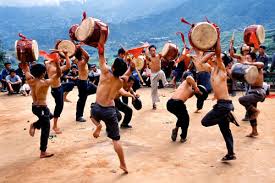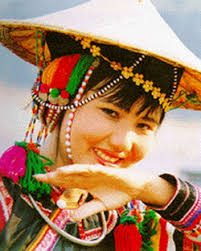Taking on occasion to Ha Nhi ethnic group, visitors will be immersed in the cultural fairs covered by bright brocade colour and see their house taking after beautiful mushroom.
Name of ethnic group: Ha Nhi (U Ni and Xa U Ni)
Population: 17,535 people (Year 1999)
Locality: Lai Chau and Lao Cai provinces.

Also called U Ni and Xa U Ni, the Ha Nhi have about 12,500 inhabitants settling in the provinces of Lai Chau arc Lao Cai. Ha Nhi language belongs to the Tibet-Burman Group. The Ha Nhi mainly worship their ancestors. They live on rice cultivation of burnt-over land or terraced fields. They are one of the groups who have a traditional experience in reclaiming terraced fields on mountain slopes, digging canals and building small dams. They use ploughs and harrows pulled by oxens and buffaloes to work the fields. The gardens are often close to their houses.
Animal husbandry is developed as well as the weaving of cloth, wattling of basketry articles. Most of the Ha Nhi can produce clothes for themselves. Women dress varies depending on the regions. The women of Lai Chau have a decorated dress in raw colours, different from the dress of Lao Cai women which is in indigo colour only.
 The Ha Nhi have adopted a sedentary lifestyle. Each hamlet contains 60 house holds. The Ha Nhi consists of many family lineages. Each lineage comprises many branches. Every year, at Tet (New Year's Day), the people of the same lineage gets together to listen to elderly men speaking about their ancestors. Some lineages recall far back their 40 generation ancestors. The children often take the name of the father or name of animal corresponding to their birthdays as their middle names. The young men and women are free to choose their partners. Each marriage goes through two stages. In the first stage, the young man and women become husband and wife. The bride comes to life with her husband's family and takes the family name of the husband according to custom of the Ha Nhi in Lai Chau province. Also in Lai Chau, matriarchy is still observed. The second stage is organized when the couple gets rich or has a child.
The Ha Nhi have adopted a sedentary lifestyle. Each hamlet contains 60 house holds. The Ha Nhi consists of many family lineages. Each lineage comprises many branches. Every year, at Tet (New Year's Day), the people of the same lineage gets together to listen to elderly men speaking about their ancestors. Some lineages recall far back their 40 generation ancestors. The children often take the name of the father or name of animal corresponding to their birthdays as their middle names. The young men and women are free to choose their partners. Each marriage goes through two stages. In the first stage, the young man and women become husband and wife. The bride comes to life with her husband's family and takes the family name of the husband according to custom of the Ha Nhi in Lai Chau province. Also in Lai Chau, matriarchy is still observed. The second stage is organized when the couple gets rich or has a child.
Funeral customs vary according to regions, but common practices have prevailed such as when a person dies, the partition making off the bedroom of the deceased is dismantled, as well as the altar to the ancestors. The dead body is placed on a bed in the kitchen and good hours and days must be chosen for burial. To determine the place of burial, an egg is tossed in the air and the grave dug where the egg hit the ground and breaks. There is no cemetery of the whole village. Around the grave, stones are piled up without building a funeral house or a protective fence. Earth grown with grass is refrained from filling up the grave.
 The Ha Nhi possess many ancient tales arc stories in long verses. The young men and women play their own dances according to rhythms and accompanied by musical instruments. The young couples used to expose their love by playing leaf panpipe, lip organ and vertical flute. The young girls like to play am ba, met du, tuy huy or nat xi (various kinds of traditional flutes) when night falls. The young boys like to play la khu, a string zither. Besides, the festivals, drums, cymbals and castanets are per- formed. The Ha Nhi also have many songs such as lullabies, duet songs, wedding songs, mourning songs and songs reserved for new houses, receiving guests and welcoming Tet holidays. Particularly, a wedding song of the Ha Nhi in Muong Te district of Lai Chau province is composed by 400 verses.
The Ha Nhi possess many ancient tales arc stories in long verses. The young men and women play their own dances according to rhythms and accompanied by musical instruments. The young couples used to expose their love by playing leaf panpipe, lip organ and vertical flute. The young girls like to play am ba, met du, tuy huy or nat xi (various kinds of traditional flutes) when night falls. The young boys like to play la khu, a string zither. Besides, the festivals, drums, cymbals and castanets are per- formed. The Ha Nhi also have many songs such as lullabies, duet songs, wedding songs, mourning songs and songs reserved for new houses, receiving guests and welcoming Tet holidays. Particularly, a wedding song of the Ha Nhi in Muong Te district of Lai Chau province is composed by 400 verses.

 bởi
bởi 

